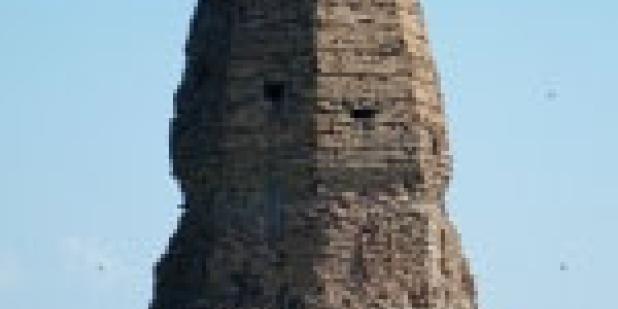Join us for a free one-day workshop for educators at the Japanese American National Museum, hosted by the USC U.S.-China Institute and the National Consortium for Teaching about Asia. This workshop will include a guided tour of the beloved exhibition Common Ground: The Heart of Community, slated to close permanently in January 2025. Following the tour, learn strategies for engaging students in the primary source artifacts, images, and documents found in JANM’s vast collection and discover classroom-ready resources to support teaching and learning about the Japanese American experience.
The Liao Revolution in Building and Design
The Fairbank Center at Harvard University presents a lecture on the architecture of the Liao dynasty (916-1125), which is known for its size and for its dramatic and often unique interior spaces.
Where

2014 Edwin O. Reischauer Lectures
Nancy S. Steinhardt is professor of East Asian art and curator of Chinese art at the University of Pennsylvania where she has taught since 1982. She received her PhD at Harvard in 1981 where she was a Junior Fellow from 1978-81. Steinhardt taught at Bryn Mawr from 1981-1982. She has broad research interests in the art and architecture of China and China’s border regions, particularly problems that result from the interaction between Chinese art and that of peoples to the North, Northeast, and Northwest.
Steinhardt is author or coeditor of Chinese Traditional Architecture (1984), Chinese Imperial City Planning (1990), Liao Architecture (1997), Chinese Architecture (2003), Reader in Traditional Chinese Culture (2005), Chinese Architecture and the Beaux-Arts (2011), Chinese Architecture in an Age of Turmoil, 200-600 (in press), The Chinese Mosque (under contract), Chinese Architecture: Ten Lectures (under contract) and more than 70 articles.
Architecture is without doubt one of the most distinctive elements of Chinese civilization. Its characteristic features – roofs, gables, columns, bracket sets – mean that everyone can recognize a Chinese building when they see one. That these and other features remained so remarkably consistent over time may lead us to conclude that Chinese architecture was a closed system, a building tradition that resisted influences from outside and in which continuities in timber-frame construction and roof decoration can be straightforwardly traced over millennia. Through the centuries, however, the highly recognizable Chinese style in building has been adopted and adapted near and far, from Japan, Korea, and Southeast Asia to England and the United States. How can an architectural tradition apparently so hidebound be so elastic?
These three lectures by the leading American historian of Chinese monumental architecture take up this question by examining developments from a time when Inner Asian regimes, and not Chinese dynasties, governed in the Central Plains. The Northern Wei state of the Xianbei, the Liao state of the Khitans, and the Yuan state of the Mongols, all represent periods of alien rule when challenges were posed to established systems of building in China. In a magisterial overview of Chinese architectural history set broadly in a Eurasian context, Professor Steinhardt demonstrates that, although it might seem that architecture changed little during those periods, buildings constructed under the patronage of non-Chinese rulers in fact stretched the building system beyond anything previously erected in China, and that what we think of as “Chinese” architecture can be thought of as constituting an early “internationalism” in building and space.
Lecture 2: The Liao Revolution in Building and Design
Since the early 20th century, the architecture of the Liao dynasty (916-1125) has been known for its size and for its dramatic and often unique interior spaces. Liao architectural forms, iconographic programs, and burial practices are unprecedented in earlier periods. This lecture offers new insights on three monuments that open fresh vistas on Liao architecture. It demonstrates first, that the two largest Buddha halls ever constructed in China, both from the eleventh century, did not follow the standards expected for most important Chinese buildings. The lecture also provides evidence that Khitan patterns of construction, symbolism, and urbanism existed outside China and Inner Mongolia during the Liao empire. This is followed by an unprecedented look at ongoing excavation of a monastery inside the Liao upper capital of Shangjing, which reveals a city plan that has no clear precedent in Asia. The lecture concludes by asking why Liao architecture distinguished itself from other building traditions.
Reception follows the lecture
Featured Articles
Please join us for the Grad Mixer! Hosted by USC Annenberg Office of International Affairs, Enjoy food, drink and conversation with fellow students across USC Annenberg. Graduate students from any field are welcome to join, so it is a great opportunity to meet fellow students with IR/foreign policy-related research topics and interests.
RSVP link: https://forms.gle/1zer188RE9dCS6Ho6
Events
Hosted by USC Annenberg Office of International Affairs, enjoy food, drink and conversation with fellow international students.
Join us for an in-person conversation on Thursday, November 7th at 4pm with author David M. Lampton as he discusses his new book, Living U.S.-China Relations: From Cold War to Cold War. The book examines the history of U.S.-China relations across eight U.S. presidential administrations.




